 Soviet Union (1940)
Soviet Union (1940)
Medium Tank – 35,467 Built
A landmark in tank history
The T-34 was and remains a legend. It is not only the most produced tank of the WWII-era, with 84,000 built (compared to the 48,966 Shermans of all versions) but also one of the longest-serving tanks ever built. Many are still stored in depots in Asia and Africa, and some served actively during the 90’s (such as during the 1991-99 Yugoslavian war). They formed the backbone of countless armored forces around the globe from the fifties to the eighties. The basic design was drawn for the first time in 1938 with the A-32, in turn partially derived from the BT-7M, a late evolution of the US-born Christie tank.
| Hello dear reader! This article is in need of some care and attention and may contain errors or inaccuracies. If you spot anything out of place, please let us know! |
The first version of the T-34/76 came as a nasty surprise for the overconfident German troops in the fall of 1941, when it was first committed en masse. Not only were they able to cope with the mud and snow with their large tracks, but they came with a perfect combination of thick and highly sloped armor, efficient gun, good speed, autonomy and, above all, extreme sturdiness, reliability, ease of manufacturing and maintenance. A perfect winner for an industrial war and a significant leap in tank design. While the T-34 did have a number of deficiencies, the T-34’s influence on the future designs and the concept of the main battle tank is unquestionable.

Links in the evolution of the T-34, left to right: BT-7M, A-20, T-34 mod. 1940 (L-11), T-34 mod. 1941 (F-34).
Early precursor: The A-32
From the BT-IS, A-20, the BT-SV’s sloped armor (1936) to the five-roadwheel A-32, the blueprint of the T-34 was set up far before the war. The team lead by engineer Mikhail Koshkin promised Stalin to replace the BT series with a better “universal tank”. The bureau designed a sloped armored box encasing a powerful diesel V12 engine which was less sensitive than the high-octane petrol engines used in previous Soviet tanks. This was done both to increase the range and to avoid bursting into flames too easily, as the BT-5 and BT-7 did during the war against Japan in Manchuria.
Hello, dear reader! This article is in need of some care and attention and may contain errors or inaccuracies. If you spot anything out of place, please let us know!
The first prototype of the T-34 was an improved A-32 with thicker armor, which successfully completed field trials at Kubinka and was simplified for mass production. It was ready as early as the beginning of 1939, as USSR was undergoing a major rearmament plan. The first two pre-series vehicles rolled out of the KhPZ factory in Kharkov (Ukraine) during the very first month of 1940, under the patronage of Sergey Ordzhonikidze. From April to May they underwent a large array of difficult trials, rolling through 2000 km (1242 mi) from Kharkov to the Mannerheim line in Finland and back to the factory via Moscow (sadly, Mikhail Koshkin, the lead designer who took part in the grueling march, became ill and passed away soon after).
T-34 model 1940
The T-34 was largely improved during trials and mass production was set up in September by Koshkin’s successor, chief designer Alexander Morozov. All previous models, the T-26, the BT-7 and the heavy multi-turreted T-28, were dropped from production to make room for the new medium tank. Production was also separated, Leningrad furnishing the L-11 gun, Kharkov – the diesel V12, Moscow – the electrical components and the armored hull, while the final assembly was performed at the Stalingrad tractor factory. After July 1941, all these vulnerable production centers saw a huge relocation effort to the east.

The T-34 model 1940, the first mass production model. The 1941 had many differences, mostly aimed towards easier production.
Only Stalingrad production remained in place until the very end of the battle, when Von Paulus’ army capitulated in early 1943. But the model 1940 was hampered by various deficiencies. The complex hull front armor piece was difficult to manufacture, there was a shortage of V12 diesels, so most of the model 1940 series tanks were equipped with the BT tank’s Mikulin M-17 engine at the Gorky factory, as well as provisional transmission and clutch. The initial L-11 76 mm (2.99 in) gun was criticized for having a low muzzle velocity and the F-34 was designed instead at Gorky. It was later put into production, equipping the first units in July 1941.
General overview
When all designed components were brought together, the new T-34 series was equipped with the final 76.2 mm (3 in) gun and was the basis for all versions until 1944. It was known as the T-34 (the Soviets do not seem to have made any effort to differentiate it from the later T-34/85). A new and improved coil-spring Christie suspension was fitted, as well as the intended V12 diesel and adapted clutch and transmission. The 10-RT 26E radio set was replaced by the 9-RS model and the tracks were slightly enlarged. The frontal armor was simplified for mass production, as well as many other elements. When out in business, the T-34 had no equivalent in the world. It was able to combine almost to perfection the magic triangle of speed, armor and armament.
The sloped armor was a good solution to deflect most hits while not relying on excessive thickness. First encounters in July 1941 proved that no German tank was able to reliably score a penetration. To the disappointment of the enemy officers, their shots simply bounced off these well-armored machines. The need for a more powerful gun, with very high velocity, was the origin of the Panther design (Panzer V).
The T-34 was equipped with a variety of hatches and turrets during its lifespan, but almost all had their upper hull equipped with railings to allow Soviet troops to travel on the tank, supplementing the lack of transports. None were ever equipped with an anti-aircraft mount and there were losses due to the new Stuka dive bomber antitank conversions (Ju-87G).
The T-34/76 was the mainstay of the Red Army from 1941 to the end of 1944, when sufficient numbers of T-34/85, a new tank in some aspects, gradually replaced them. The T-34 was a real shock for the Germans, as they had nothing like it. The sloped armor proved highly effective, despite their relatively low muzzle velocity gun, which was favorably compared to the guns of Panzer III and IV of the time. Their diesel was sturdy and able to cope with extreme weather conditions, their wide tracks were perfectly shaped to cope with the “rasputitsa” (a sea of mud) in autumn and the snow in winter. It was much easier to produce than any Panzer model before it and, for many frontline German units, the T-34 seemed like a difficult foe. Of course, that was not always true. A well-placed hit between the tracks and wheels could still disable them. And on the defensive, the German 88 mm (3.46 in) guns had no issues dealing with them.
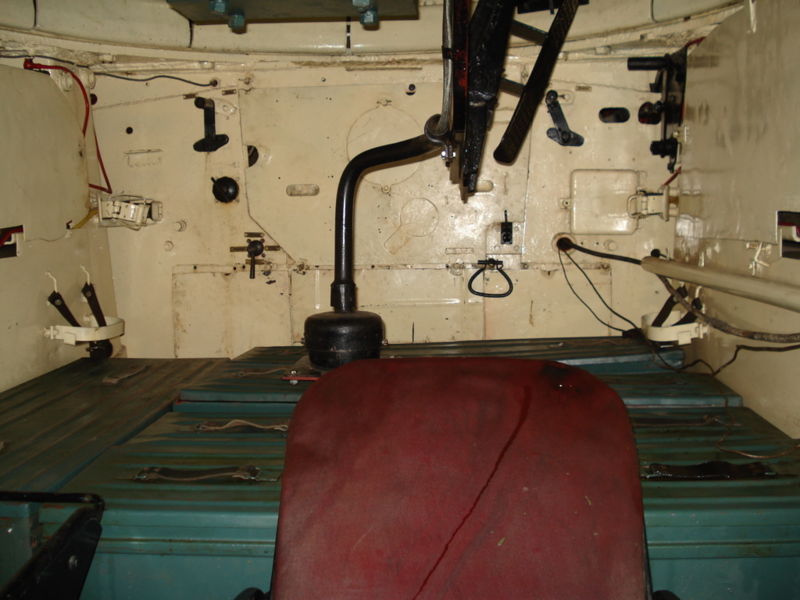
The T-34 model 1941/42 interior. The floor where the commander stands is made of ammunition cases. The finishes and equipment were limited to the bare minimum.
Tactics
At the end of 1942 came a new version, the model 1942, limited to minor improvements to crew comfort and vision systems. The 76 mm (2.99 in) gun could fire high explosive rounds as well as armor-piercing ones. These were fatal to all Panzers except the late, heavily protected versions of the Panzer IV. They were sometimes paired with the slower but heavily armored KV-1 tanks. But German tactics, like in France, proved superior, and both well-coordinated Stuka attacks as well as the 88 mm (3.46 in) guns prevented the Russian T-34s from overwhelming the enemy. During the Moscow winter campaign and later at Stalingrad, the T-34s were massively engaged for the first time and overwhelmed German defenses. German tanks (and troops) were crippled by the icy weather.
The rubber from the wheels peeled off, the engines were slow to start and had to be slowly warmed up, machine-guns often jammed and mobility was almost impossible as the narrow tracks of the Panzer III and IV caused them to literally sink in the snow. Additionally, bad weather interfered with the aerial support, preventing any help from the Luftwaffe.
However, the new Panther proved lethal at long range against the T-34, which still had to catch its prey in close combat in order to penetrate the German tank. These tactics proved decisive at Kursk, when hundred of Panthers and Tigers, while being efficient at long range, were overwhelmed by thousands of T-34s striking from all sides.
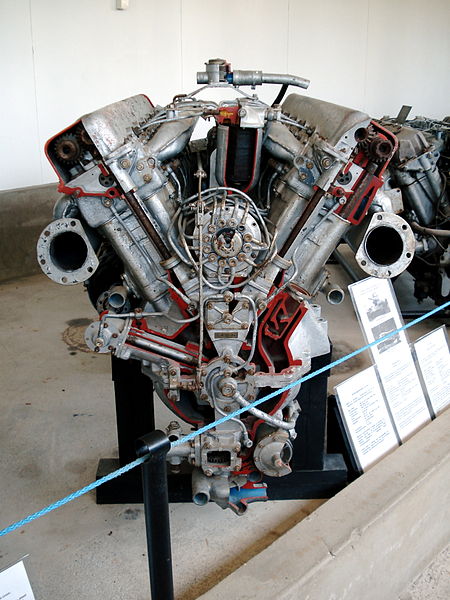
V12 Diesel engine at Parola
Production problems
The T-34 was not the “perfect” tank that history and the internet sometimes make it seem. Poor quality assembly, roughly welded joints, combined with overall very harsh running conditions as well as low training quality, sometimes inept commanders, took their toll on every division equipped with the T-34. In some occurrences, more than half of the tanks engaged in combat were lost due to mechanical breakdowns and other teething problems.
The diesel engines were particularly sensitive to dust and sand. The first filters proved ineffective. The transmission and clutches often caused a serious amount of vibrations and occasionally failed. The T-34/76 was also often criticized for its cramped fighting compartment. Regardless of its quality, large numbers of T-34’s were lost due to lack of communications and poor doctrine.

A file of newly produced T-34 model 1942, en route for the frontline. These can be identified by their hexagonal turrets and the open twin “Mickey Mouse ears” hatches.
Sometimes entire spare transmissions and other mechanical parts were stowed on the tank, between the extra fuel tanks, next to the tarpaulin, shovel, pickaxe, iron cable and spare track links. At times, the lack of support vehicles forced the T-34’s to become their own support vehicles. In a major relocation effort due to the rapidly advancing German forces, the assembly lines were moved to the Dzerzhinski Ural Railcar Factory in Nizhny Tagil and Stalin Tractor Factory in Chelyabinsk (“Tankograd”), undoubtfully a difficult task for the thousands of people involved. But until the fall of 1942, the biggest part of the production came from eastern Stalingrad. There, the T-34s were thrown into combat right at the factory door.
The T-34/76 model 1941
This model was similar to the previous 1940 model. The most important improvement of Model 1941 was the more efficient, longer-barrelled F-34 76.2 mm gun. Many components were put under scrutiny for mass production, like the new gun mount, the welded turret with a new, single, wide hatch, and many other parts. The single hatch was retained for ease of production, but it was heavy and easily jammed, trapping everybody inside. In fact, it was hated by the crews (who suffered due to the poor comfort and poor ergonomics), being quickly dubbed the “pirozhok” (stuffed bun). The very large rear exhaust covers were another feature which did not last long. The turret lacked sufficient protection for the commander, with no special-purpose hatch or traversable periscope.

The T-34 model 1942 (left) and T-43 (right) side to side. The T-43 was a heavier derivative of the T-34, with the aim to replace both the KV-1 and the T-34. It had a much thicker armor, torsion-bar suspension and a three-man turret. After the Kursk Battle the project was canceled, as both mobility and armor thickness were insufficient facing the Tiger’s 88 mm (3.46 in) gun.
The single heavy, forward opening hatch had a single vision slit. Moreover, the commander was also responsible for aiming and firing the gun, due to the four men crew. This was not corrected until the introduction of the three-man turret with the T-34/85. Later on, many models had additional armor plating like the T-34E (“ehkranami” – screened) to answer the latest German gun development. The armor was largely improved compared to the 1940 model. Some 324 T-34’s were rearmed with a special high-velocity 57 mm (2.24 in) gun ZiS-4 or ZiS-4M, under the name of T-34/57, and used as tank-hunters, notably during the battle of Moscow.
The T-34/76 models 1942 to 1944
As the standardized machine tools used for the T-34 were not easily adaptable, changes were rarely introduced into the production process. Many features of the T-34 remained unchanged until 1942, despite the complaints of the crews and their commanders. The process was made simpler and the parts cheaper. For example, the commonly used F-34 gun was simplified to the point that nearly 200 pieces less were needed (from 861 to 614).
The gun sights and range finder remained crude, despite the fact that several gun mounts were alternatively used. The poor optics prevented the crews from using their guns at long range like the Germans often did. This led to aggressive tactics based on constant maneuvering, while the German tanks could stand in place and fire at approaching targets from a distance.
The lack of rubber often prevented the use of the standard rubberized wheels, and many bare-metal wheels of various designs were used. This can be seen on photographs as a strange mix of wheels. Early 1942 saw the introduction of a new, much better hexagonal turret, a sub-product of the abandoned T-34M project, which was a great improvement over previous models. Notably, the big hatch was removed and replaced by separated hatches (dubbed “Mickey mouse” by the Germans, due to the way it looked from the front with the hatches open).
In the fall of 1943, the turret received a new specially-designed all-around vision commander cupola. Production cost was halved and production time reduced by 50% despite the fact that most of the male workers left for the battlefield by that point, and were replaced by women, children, disabled, or the elderly. In 1943 T-34 production rate was about 1300 per month. Quality standards were poor and they were roughly finished, even by US mass production standards. The last model was the T-34/76 model 1944, with the simplified ZiS S-53 gun, turret radio and improved commander sights. However, production was gradually decreased to make way for the significantly better T-34/85.
The T-34/85
As the war went on, German Panzers greatly improved, mostly to deal with the T-34. Not only did many tank-hunters appear, but also the later generations of the Panzer IV with additional armor plates, the Panther and, of course, the Tiger. The Morozov design bureau was well aware of the limitations of their 76 mm (2.99 in) gun, especially after the battle of Kursk, such as its insufficient range and armor-piercing capabilities. A new high-velocity model was needed, which was derived from a successful anti-aircraft gun, the ZiS 85 mm (3.35 in), mimicking the legendary German Flak 88 mm (3.46 in). The project targeting to replace both the KV-1 and the T-34 was the T-43.
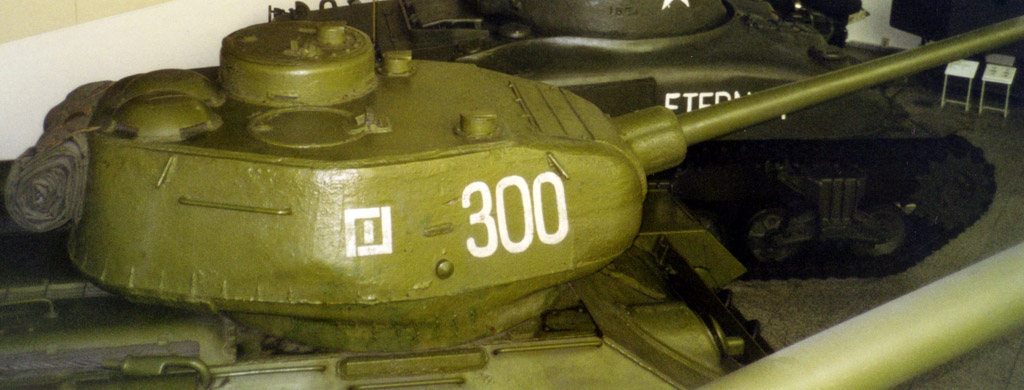
The 3-man T-34/85 turret – a significant improvement over the T-34 model 1943 hexagonal turret.
After the battle of Kursk, the T-43 project was abandoned while its turret was used to improve the T-34, in what will become known as the T-34/85. This brought two major improvements, the first being the new, more effective gun, and the brand new turret itself with more internal space for the five crew members. With the new dedicated gunner position, the commander could concentrate on commanding the tank. This new version proved far superior and gradually replaced earlier versions.
Eventually, the overall T-34 production rate significantly increased. By 1944, the Red Army had a large number of both T-34/76 and the T-34/85, in various versions. The T-34/85 was not immune to the Tiger, the 88 mm (3.46 in) gun and the PaK 40. While the new turret was better sloped, it also made the tank taller and thus an easier target. Production of the T-34/85 reached 22,559, outnumbering the superior Panthers and Tigers.
Captured T-34/76’s
As the war had the Soviets at a disadvantage until December 1942, many T-34’s were captured during the Blitzkrieg. Abandoned tanks were often found in somewhat good condition. Mechanical problems were likely the cause, due to the still relatively new design, hasty production with poor quality standards, lack of maintenance and fuel, and overall rough service conditions. Entire units were also captured or even depots which had not been evacuated on time. Additionally, some tanks were disabled in combat, but not beyond repair. During this process, the Wehrmacht incorporated an estimated 400 tanks of nearly all models, from the model 1940 to the 1943, under the name of Panzerkampfwagen T-34(r) or T-34 747(r) for the T-34/76. Since the Germans were impressed by these tanks (Guderian, Von Kleist and Blumentritt among others), they took all possible means to restore and return to battle these valuable trophies. Most of the time, few changes were made except for the proper German camouflage and very large Balkenkreuz’ painted on the turret, hull and roof. Large swastikas were also used to make the tanks recognizable by the German tank and air crews. The Germans also added equipment and, eventually, additional armored plates.

T-34 pressed into service with the Wehrmacht.
The first Axis user of the T-34 was the regular Wehrmacht, which incorporated many model 1941s and far more model 1942s in the 1st, 8th and 11th Panzer Divisions during the summer of 1941. All captured units were sent to a Riga workshop, but also Marienfeld and Goerlitz, receiving new radios, fitted with a German-style commander cupola, new hatches and other minor equipment. Many badly damaged T-34s were kept for spare parts. Some turrets were removed and mounted on the many armored trains (Panzerzug) which roamed the Eastern front. Other served as training tanks, but the majority were used in regular units and some by the SS units, like the 3rd SS Panzer Division “Totenkopf” and “Das Reich”. They added Schürzen (armor skirts), Notek lights, storage boxes, tools, radios and commander cupolas removed from damaged Panzer IIIs and IVs. These units also incorporated a handful of supply T-34 conversions (Munitionspanzer T-34(r)) and a few AA conversions (Flakpanzer T-34(r)). The Ukrainian “Liberation Force” of Vlasov also used many captured T-34s, which showed a blazon with the traditional St Andrew cross and “ROA” (for Russian Volunteer Army). The Finns also captured many T-34s and painted them with a three-tone camouflage and large swastikas.

A Polish T-34/85 in 1945. Notice the Polish eagle on the turret. The T-34/85 was a massive export success. The last were seen fighting in ex-Yugoslavia in 1996.
The Cold War & exports
The T-34/85 was still produced after the end of the war in September 1945. They formed the bulk of the Soviet summer offensive in Manchuria in August 1945. They proved far superior to any Japanese tanks or guns. By that point, it was quite cheap to produce, relatively easy to maintain and was overall superior to most Allied tanks at the time, except for the British Centurion, the American M26 Pershing and the later developments of the M4 Sherman. With huge stocks available and the new tank generation arriving on the scene (like the IS-3 and the mass-production T-54/55), many T-34s were sent to the USSR allies and satellite states behind the Iron Curtain. They ultimately formed the bulk of their armored force until the early 1960s, seeing action during the Korean war, with North Korean and Chinese forces (which also used the locally built Type 58 version).
They also formed the core of many Arab countries’ armored forces in the Middle East (like Syria and Egypt), then opposing upgraded Shermans and the definitely better Israeli Centurions. They also formed an essential part (alongside the more recent T-54s and T-55s) of the North Vietnamese regular armored regiments. They were sold to many emerging countries, sometimes barely modernized with better optics and electronics, and remained in service until the end of the Cold War. Current or former operators include: Albania, Austria, Bulgaria, Cyprus, Czechoslovakia, Cuba, Finland, East Germany, Hungary, Poland, Romania, Yugoslavia, Afghanistan, Iraq, Laos, Mongolia, North Korea, Palestine, Pakistan, People’s Republic of China, Syria, Vietnam, South Yemen, North Yemen, Africa, Algeria, Angola, Republic of Congo, Egypt, Equatorial Guinea, Ethiopia, Guinea, Guinea-Bissau, Libya, Mali, Mozambique, Namibia, Somalia, Sudan, Togo, and Zimbabwe.
T-34/76 Mod. 1940 Specifications |
|
| Dimensions (l-w-h) | 5.95 x 3 x 2.40 m (19’6″ x 9’10” x 7’10”) |
| Total weight, battle ready: | 26.8 tonnes |
| Crew | 4 |
| Propulsion | V12, 500 hp @1800 rpm |
| Speed | 54 km/h (33.5 mph) |
| Range, off road/on road | 227 km (141 mi) / 292 km (181 mi) |
| Fuel capacity | 455 liters (120 US gal) |
| Armament | L-11 76.2 mm (3 in) gun 3x DT 7.62 mm (0.3 in) machine-guns (1 stowed) |
| Armor | Hull front and sides up to 45 mm (1.77 in) Hull top/bottom 16 mm (0.63 in) Turret 45 or 52 mm (1.77 or 2.03 in) |
| Total production | 35,467 total T-34/76 (84,070 with T-34/85) |
T-34/76 Mod. 1941 Specifications |
|
| Dimensions (l-w-h) | 5.92 x 3 x 2.40 m (19’5″ x 9’10” x 7’10”) |
| Total weight, battle ready: | 28.12 tonnes |
| Crew | 4 |
| Propulsion | V12, 500 hp @1800 rpm |
| Speed | 55 km/h (34 mph) |
| Range, off road/on road | 250 km (155 mi) / 300 km (186 mi) |
| Fuel capacity | 465 liters (123 US gal) |
| Armament | F-34 76.2 mm (3 in) gun 3x DT 7.62 mm (0.3 in) machine-guns (1 stowed) |
| Armor | Hull front and sides up to 45 mm (1.77 in) Hull top/bottom 20 mm / 16 mm (0.79 / 0.63 in) Turret 45 or 52 mm (1.77 or 2.03 in) |
Sources
“Domestic Armored Vehicles. 20th Century. Vol 1: 1905-1941” A.G. Solyankin, M.V. Pavlov, I.V. Pavlov, E.G. Zheltov / Отечественные бронированные машины. ХХ век. Том 1: 1905-1941. А.Г. Солянкин, М.В. Павлов, И.В. Павлов, Е. Г. Желтов.
T-34 video on Youtube
The T-34 on Wikipedia
The T-34 on Soviet-empire.com
Captured T-34 in German service (Achtungpanzer)
Other T-34s in German service
Diagram: www.howitworksdaily.com/wp-content/uploads/2012/02/T-34_cutaway.jpg

The T-34/76 model 1940 was the first production version, largely derived from the previous A-32 prototypes like the T-34 Obr.40-3. Hundreds of them were about to be put in service in July 1941. Around 1066 were ready when Operation Barbarossa was launched. They performed well despite the lack of training of their crews and inept command, just like the KV-1. The Panzers couldn’t match them in one-on-one combat, but the poor doctrine and low numbers of T-34’s available made the new tank quite vulnerable, and many were lost.

A T-34 Model 1940 of the Moscow Rifles Guard Battalion, summer 1941 (with the L-11 76 mm gun). This three-tone camouflage pattern was quite rare and only appears in a handful of photographs.

A T-34/76 model 1941 with a very unusual two-tone winter livery of the Soviet Red Guards, in the fall of 1941 (note the new F-34 76 mm gun). This scheme was perhaps obtained through chemical treatment of the washable white paint over the factory olive green.

The T-34/76 model 1941 was a cheaper and simpler production version of the 1940 model, with many improvements. These included welded elements and a new two-piece cast turret, with a new wide hatch which became one of the striking characteristics of the T-34. By this point, most T-34’s were equipped with the new F-34 76 mm gun. Railings were added on the hull, sometimes a standard piece with two folds or a simpler version with a simple tube running all along the upper part of the sloped hull. T-34’s were used as improvised transport in the heart of battle, mostly due to their impressive off-road capabilities that few trucks could match at that time. Here is a model 1941 from the Moscow sector, January 1942. Slogan: “For Stalin, for the USSR.”

A T-34/76 model 1941. Unknown unit. The painted slogan: “Zoya Kosmodemyanskaya.”

Up-armored T-34/76E model 1941 “Ehkranami” (with extra bolted appliqué armor). Caucasus Region, spring 1942. Slogan: “For Russia”.

T-34 Model 1941, unknown unit, Northern sector, early 1942. Slogan: “For the Fatherland”.

T-34/76 model 1941, 5th Guards Army, November 1942.
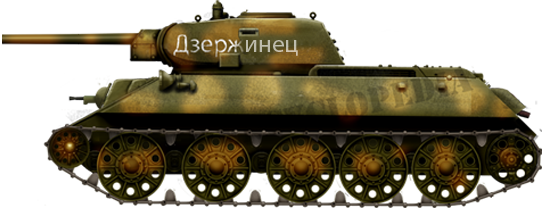
A late model 1941 with all-metal wheels. The two-tone camouflage is attested through photographic evidence, but it was quite rare. Central front, spring 1943.

T-34/76 model 1941/42, transition production from the STZ factory, Stalingrad, January 1942.

Early production T-34/76 model 1941, with a makeshift sand painted camouflage, unknown unit, southern front, summer 1942.

T-34/76 model 1941, Finnish sector, lake Ladoga, winter 1942/43. Notice the camouflage made of crossed white paint bands. This created a pattern when seen from far away.

A T-34/76 model 1942 in winter livery, Stalingrad, January-February 1943 offensive.
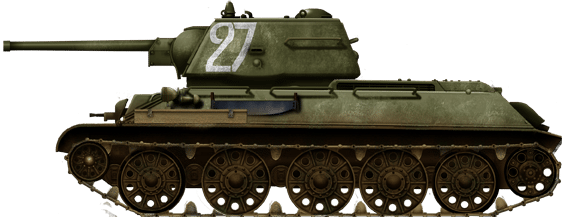
T-34/76 model 1943 at the battle of Prokhorovka, July 1943. Notice the mix of ruberrized and metal roadwheels. The latter were rather in the middle so that the hardest cushion was applied to both ends of the chassis. Notice also the welded handbars of the late model.
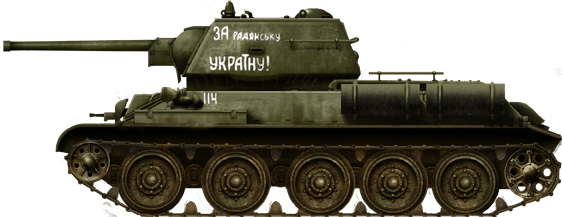
T-34/76 model 1943, unit unknown, Kursk, July 1943.
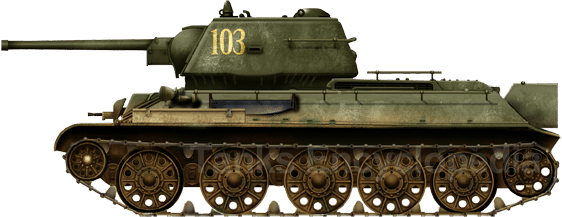
T-34/76 model 1943, unit unknown, Kursk, July 1943. Notice the rear additional tanks.

The T-34/76 model 1942 had some improvements over the 1941 model. It received the new twin hatches, earning it the “Mickey Mouse” nickname from the Germans. The addition of a better turret and mass production were the main goals of the model 1943 version, with many simplified parts to lower the cost and increase the rate of delivery. At Stalingrad, these models, famously built at the “Red October” and “Barricade” factories, were literally thrown into battle at the end of the production line, in bare metal finish, often without any kind of markings.

T-34/76 model 1943, Belgorod-Kharkov Offensive, August 1943. Notice the makeshift extra protection, comprising of a wooden crate filled with sand and a pruned tree trunk.

T-34/76 model 1942 at Kharkov, spring 1943. Notice the rare two-tone camouflage, probably applied using sand and some adhesive, and the mixed metal and rubberized road wheels. The T-34/76 model 1943 received the new turret with twin hatches and better optics, which improved the efficiency of the commander.

During the fall of 1943, all vehicles received a new commander cupola, which greatly improved his visibility on the battlefield. However, production standards were poor and many tanks were lost due to mechanical breakdowns. The model 1944 was systematically equipped with the new turret, with a wider commander cupola and some extra armor. External equipment included spare tracks, tools boxes, fuel tanks and improvised protection of all kinds. Of these, for example, were entire pruned trunks, rails, scrap metal and, during the battle of Germany and especially in Berlin, an improvised Panzerfaust defense made of spring beds or various metal frames.
Captured vehicles (Beutepanzer)

Panzerkampfwagen T-34(r), with the dunkelgrau livery. Ukraine, Panzergruppe South, spring 1942.

Panzerkampfwagen T-34b(r) 1942, Kursk salient, summer 1943.

Beute Panzerkampfwagen T-34c(r) in autumn camouflage, Poland, fall 1944.
Variants & derivatives
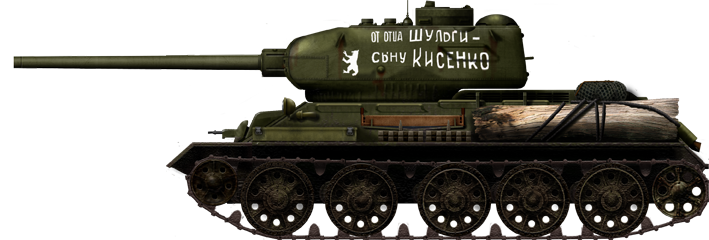
T-34/85: the main evolution of the T-34/76. They were basically late production T-34s rearmed with the high-high velocity, long barrel ZiS-S-53 85 mm (33) gun, a derivative of an AA gun, and a brand-new, three-man turret to house it. This version far outlived the war, as the last left the factory in 1958, after a staggering 48,950 had been delivered. It formed the basis for all Russian MBTs to come during the Cold War. >

SU-85: this was the most proficient derivative of the T-34. It used the same chassis but was equipped with the high velocity 85 mm (3.35 in) ZiS-S-53. Around 3000 were built, but the production was stopped as the first T-34/85s rolled of the production line.

SU-122: a 122 mm (4.8 in) howitzer SPG (1150 built in 1943-44).
Gallery
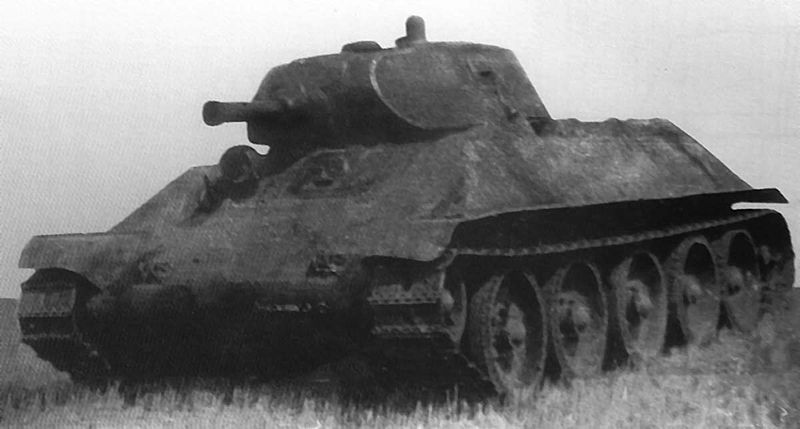
A-32 tank prototype (Unknown origin)
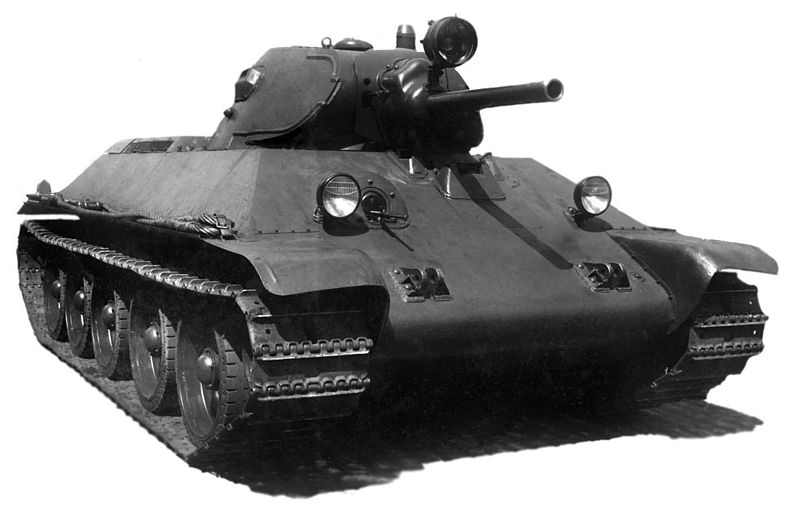
T-34 model 1940 (wikimedia commons)
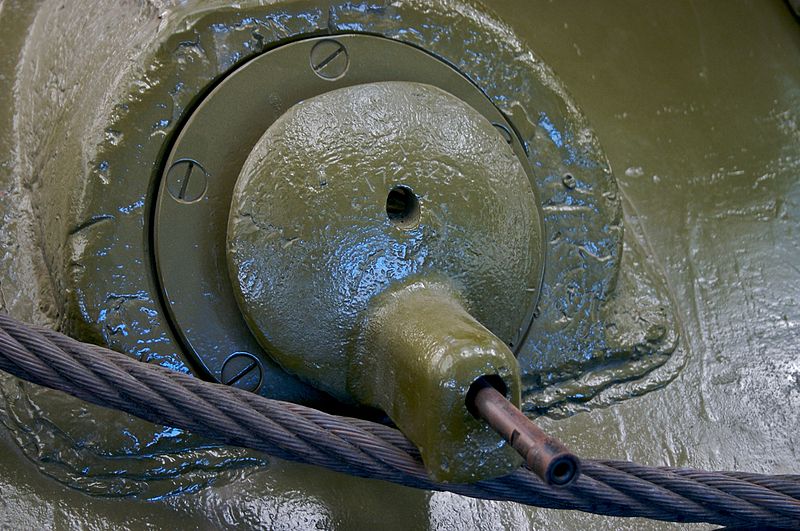
The hull ball mounted machine gun of a T-34 (wikimedia commons)
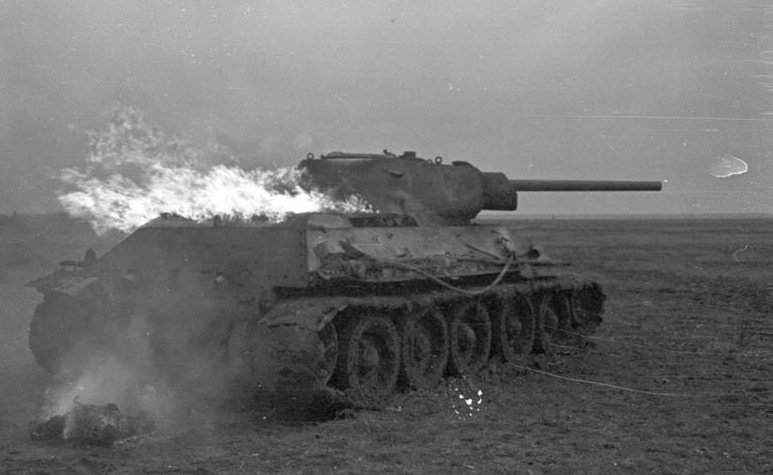
Burning T-34 in Russia – Credits: Bundesarchiv
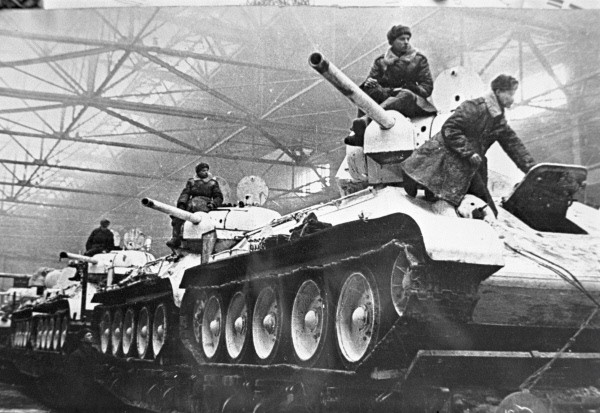
T-34 on train wagons en route to the front – Credits: Archives RIAN
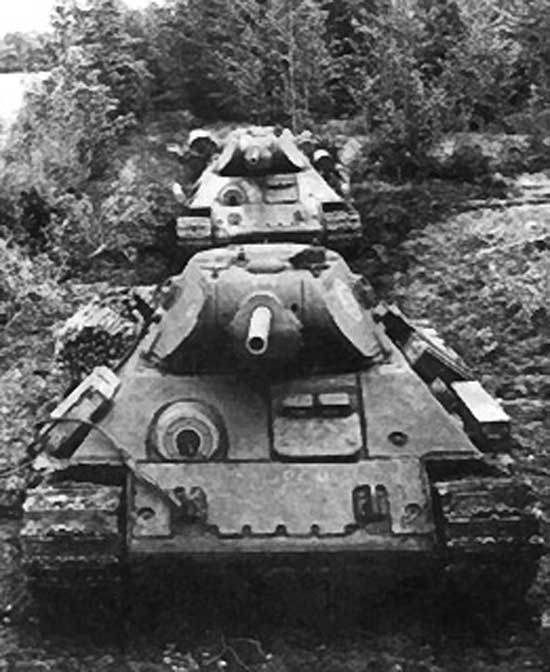
Two T-34 tanks going off-road (wikimedia commons)
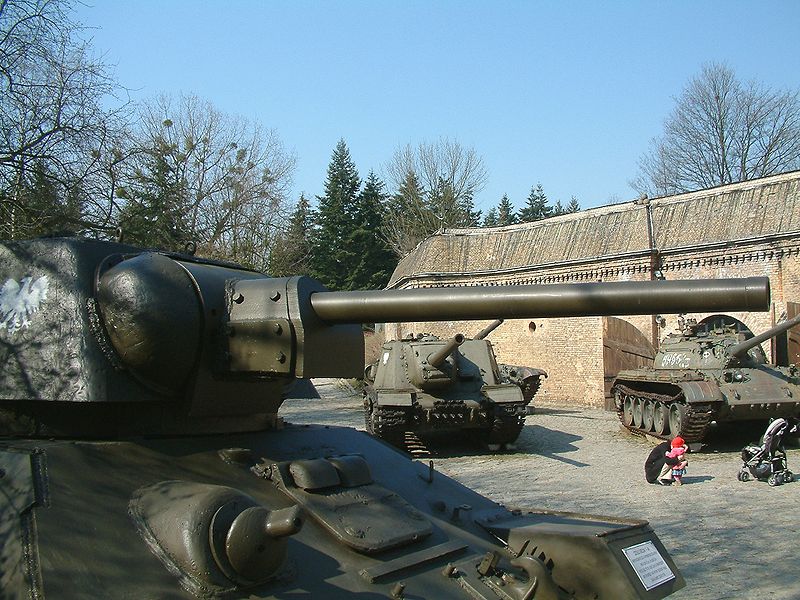
The gun of a T-34/76 (wikimedia commons)
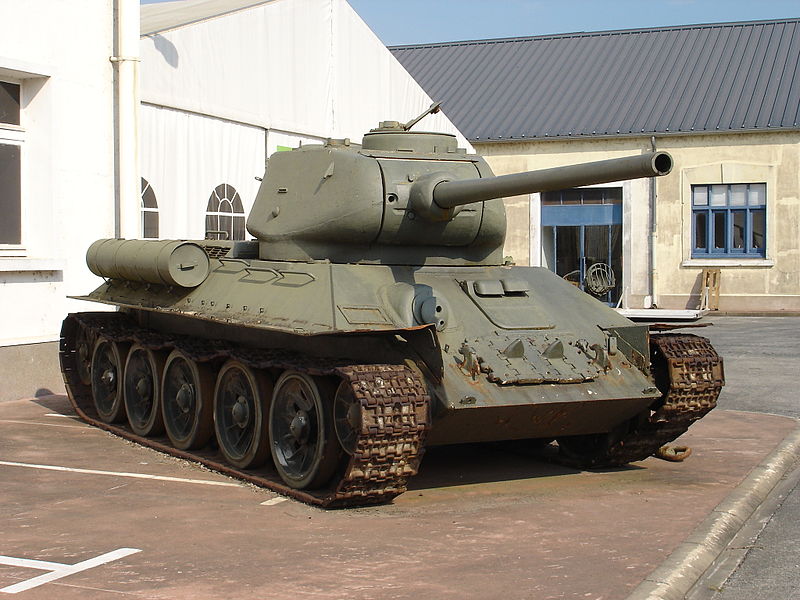
T-34/85 at the Saumur Museum (wikimedia commons)
T-34 Shock: The Soviet Legend in Pictures by Francis Pulham and Will Kerrs
‘T-34 Shock: The Soviet Legend in Pictures’ is the latest must have book on the T-34 tank. The book was authored by Francis Pulham and Will Kerrs, two veterans of Tank Encyclopedia. ‘T-34 Shock’ is the epic story of the T-34’s journey from humble prototype to so-called ‘war-winning legend’. Despite the tank’s fame, little has been written about its design changes. While most tank enthusiasts can differentiate between the ‘T-34/76’ and the ‘T-34-85’, identifying different factory production batches has proven more elusive. Until now.
‘T-34 Shock’ contains 614 photographs, 48 technical drawings, and 28 color plates. The book begins with the antecedents of the T-34, the ill-fated BT ‘fast tank’ series, and the influence of the traumatic Spanish Civil War before moving to an in-depth look at the T-34’s prototypes. After this, every factory production change is cataloged and contextualized, with never-before-seen photographs and stunning technical drawings. Furthermore, four battle stories are also integrated to explain the changing battle context when major production changes take place. The production story is completed with sections on the T-34’s postwar production (and modification) by Czechoslovakia, Poland, and the People’s Republic of China, as well as T-34 variants.
The book price is a very reasonable £40 ($55) for 560 pages, 135,000 words, and of course, the 614 never-before-seen photographs from the author’s personal photograph collection. The book will be a superb tool for both the modeler and the tank nut alike! Do not miss this epic book, available from Amazon.com and all military book stores!

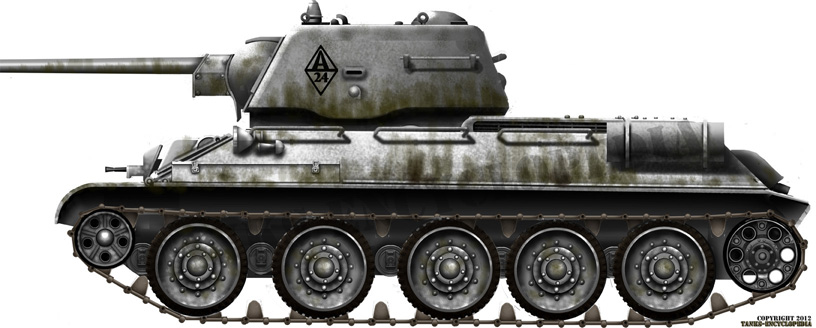

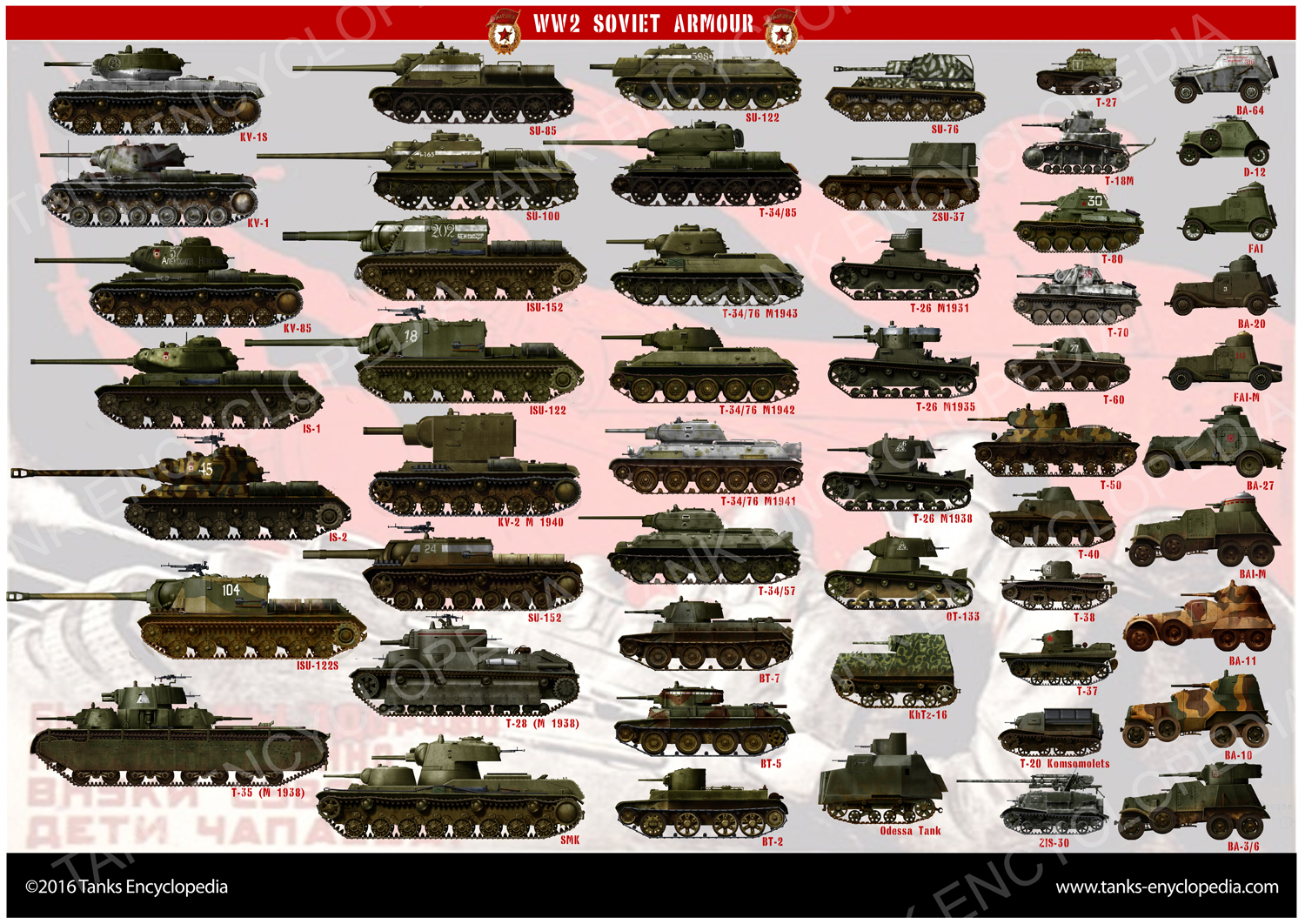
55 replies on “T-34-76”
The single hatch on the T-34 M1941 existed on the M1940 as well. Every single picture of the T-34 M1940 shows a single hatch. I couldn’t find any evidence that it was added on the M1941 and not simply taken over from the M1940.
Great website. So much data. Many thanks.
Hi. Excellent article. Found a little boo boo though (you can’t be an expert in all branches of the military hardware i guess) 🙂 “None was ever equipped with an anti-aircraft mount and many were lost because of this in 1944 due to the new Stuka antitank conversions (Ju-47D).”. I believe you meant Ju 87? Actually G model, the famous Kanonenvogel, was the specialised anti-tank version.
You are correct! The modification has been made!
Thank you for your many comments! This article is currently undergoing a revision. For the time being, I’ve separated the specifications table into 2, one for Mod. 1940 and another for Mod. 1941. I’ve also updated the specifications using a better source. Of course, the line between the specific versions of the T-34 is blurry (different factories made different versions at the same time).
http://ftr.wot-news.com/2013/08/03/cheating-at-statistics/
You might have heard some kind of ridiculous figures like “Each Tiger would take out 10 T-34s”. First of all, let’s start with the fact that a Tiger that even engaged enemy tanks on its own in the first place was not doing its job. Tigers were meant to act as parts of assault groups, accompanied by infantry, assault guns, and tank destroyers. Even if a s.Pz.Abt goes off on its own and starts fighting enemy tanks, we run into a different problem. German tank losses were counted much differently than Soviet losses. A German tank is considered lost if it is destroyed, and, more importantly, there is no longer hope of recovering it. That is why losses can show up days, even weeks, after the tanks have actually been destroyed. When looking for German tanks losses, a much more reliable method is to look at dead crew members. You can’t fake those.
On the other hand, the Germans would claim an immobilized Soviet tank in no-man’s land as a kill, even if the Soviets would recover it later. A German tank in the same position would not be counted as a loss, but a Soviet one would be, even if the Germans didn’t actually do any work to knock it out! Pretty sneaky.
http://tankarchives.blogspot.se/2013/06/cheating-at-statistics-part-2.html
Let’s count the claims in that article, and compare them to reality.
KVs: 1 actually destroyed by the Germans, 4 lost in total. Germans claim 5 KVs. Claim inflation: 500%.
T-34s: 8 actually lost (let’s give them the MIA one), Germans claim 16. Claim inflation: 200%
Everything one needs to know about the T-34 is here
http://ftr.wot-news.com/2013/09/05/common-myths-about-wwii/
Which gives 2 links to the US tests and the Soviet response to these tests
http://tankarchives.blogspot.se/2013/04/aberdeen-t-34-and-kv-1-test.html
http://tankarchives.blogspot.se/2013/04/aberdeen-british-intelligence-bulletin.html
Here are the facts about “statistics”
http://ftr.wot-news.com/2013/08/03/cheating-at-statistics/
http://ftr.wot-news.com/2013/07/28/please-dont-use-the-5-m4s-1-panther-myth/
Here are the facts about the accuracy
http://tankarchives.blogspot.se/2013/05/accuracy-revisited.html
http://tankarchives.blogspot.se/2013/02/accuracy.html
He debunks many of the revisionists myths, but of course there are far more people with an axe to grind against the USSR and its WW2 performance than their are people interested in the real truth.
Also if I may add the article here in Tank Encyclopedia is good, but it does include some the details the revisionist who have an axe to grin against the USSR have written.
The T-34 was a good tank, but any good tank will perform badly if its crew is only given 3 days of classroom training and then expected to perform, add this the political mess the army was in during the first half of the war and you get what you get. The tank itself was fine, the lack of training, logistics (in the early part), and the impossible orders, would mean any tank of any quality would do “bad”.
Then of course the lack of radios on models until 1943 meant that every tank sent into battle without a radio was an incomplete tank.
The most important part that people seem to have forgotten over the years. A tank is an anti soft target weapon, it often, but not always, is meant to fight infantry and soft vehicles. Anti-tank weapons both stationary and mobile are meant to be used against other tanks.
The T-34 is a good example of this. From 1943 90% of all tank losses were to anti-tank guns, the other 10% were to planes, infantry, other tanks, mines, and everything and anything that was not an anti-tank gun.
Hello John, thanks for you insight.
The T-34 article will be adressed and probably rewritten in the future, however we do not consider the revisionistic tankarchives to be a reliable, independent source (there have been discrepancies between posted material and inquiries which we directed towards the Bovington Tank Museum), neither the WoT forums (occassionally, useful information is posted, but usually out of context). They do not fullfill the criteria of correct research, i.e. they are very selective (to put it mildly). Primary sources are always desireable with 2ndaries supporting the postulate. If WoT or WT would represent the benchmark for tank warfare, then the Soviets would rely on flag communication during 41 and the Germans would have fuel shortages in 42.
I do not see how your posts (and their content, which is known) debunk any of the problems that were present with the vehicle, you have to admit that histography tended to notoriously overglorify its performance. I personally think preliminary reports and the Journal of Slavic military studies, information provided by an Engineer and former Platoon Cmdr who actually worked with these AFVs is more reliable, the same can be said about russian military archive information/literature, analyses of Soviet documents (for their accuracy and credibility) – this kind of information is of course difficult to obtain.
It has to be pointed out that out of 55,000 T-34s, 46,000 perished during the war, a testimony to its performance, regardless of the cause. If any German weapon system would have sustained such losses during the war, literature would have titled it as a failure. The T-34 is a victim of wartime propaganda and was used as an alibi for the Wehrmacht (or their failures for that matter).
The Aberdeen trials were never truly published, the only information is of nuncupative nature.
Accuracy is a relative term, I do not see a big issue with that (you cannot do many mistakes with such a gun design anyway, at least regarding the paper characteristics). The problem revolved around the optics which were initially of lower quality (besides a FCE penalty and radio insufficiencies up until 43 or a bottleneck of unskilled labour and that is only scratching the surface). However quality and accuracy are relative terms, German and British guns enjoyed an advantage.
Cause of tank losses differed by front and period, in a defensive phase AT guns played a more significant role, if we look at causes of T-34 losses, it is obvious that in the initial phases of Barbarossa many tanks were destroyed by 37-50mm fire (besides the most common element, operational losses and abandonment) and later to 75. It is true that a large amount of tanks were knocked out by AT fire and Mines, tank fire constituted 1/3 of the losses (14.8 to 33% deviation). It is noteworthy that during evaluations (both Soviet and German alike) it was observed that it was difficult to determine if a tank has been hit by an AT round from a tank or from an anti-tank gun. Regarding “kill claims”: “German artillery, tanks and self-propelled guns did not stop firing against tanks until
they caught fire, even when the tank had stopped as a result of being hit by a shell. Such a method of fighting against attacking tanks leads to enormous irreparable losses in their ranks.’ See ‘Documents: Tank Forces in the Defense of the Kursk Bridgehead’ (note 83)p.144.
Crew mortality on the eastern front tended to be higher than in the ETO 44, compare Ref. № 632/3 11/IX-44 y., Report of spec.lab. NKV № 101-1 and following.
Tanks had a specially designated role, breakthrough/encirclement/support, they inflicted about 5-6% of the total losses of each respective army. Most people tend to focus too much on this aspect, which is contradictory to the nature of warfare (a “tank fetish” so to speak).
“Each Tiger would take out 10 T-34”: These stories can be hardly taken seriously and are usually a product of fiction, such as exaggerated claims by Wittmann, Rudel et aliae. If anything the Panzerkampfwagen VIs role in the war was subsidiary.
OKH did have a correction system, not sure about STAVKA, interestingly document Bb 741/43 Verluste Ost in 43 shows that a 30-50% correction system for the Wehrmacht gave fairly accurate numbers while Soviet claims were exaggerated by 80,90-140% (in relation to combat intensity).
Pure Tank vs tank contigencies occured rarely, but If we look on the outcomes of Panzer battles, the Germans frequently sustained lower casualties. This gap can be partially explained by the discrepancy in development levels of both nations, besides direct factors such as recovery and repair, training and control of the battlefield.
If we look at combat reports on the eastern front (multiple tank engagement samples), it becomes apparent that the Axis forces enjoyed a substantial advantage (CEV). Even in the late phase of 45 (22,372 evacuated), the AFV losses exceeded intolerable levels (the best way to compare German with Soviet AFV losses is to look on “evacuated vs totalausfälle”, one example for 44 TsAMO f38 on11371 d16 l11,13 evacuated from combat 29,009 tanks and SU’s, 8,754 fixed at homeland repair depots, 16,129 dismantled. Of these, 1,322 T26 and T70 combat lost, 73 T26 and 377 T70 depot repaired. 17,532 T34 combat lost, 6,441 depot repaired. 2,784 KV and JS tanks combat lost, 227 KV and 932 JS depot repaired.). Soviet reports do depict a rather grim picture.
Kursk is a good example, since both armies were at their Apex strength. The battle marked the prelude to the heavy fighting in 43 and casualty wise it was undecisive. During Zitadelle the Soviets were in the defensive (an attacker usually takes higher losses) before the counterattack in the northern salient occured and still sustained thrice the amount of losses, with higher material/AFV losses amounting to 1614 SPGs and Tanks from 5-23rd July (Grif Sekretnosti Sniat and Rysskii Arkhiv: Velikaya Otechestvennaya 4(4), Kurskaya Bitva) opposed by the Axis losses, with 849 for the whole of July and approx. 300 for Zitadelle (BA-MA RH 10/65 ff., and MH, das Heer). Both factions replaced their losses rather quickly, with the Soviets further increasing their strength relative to the low combat intensive “build up phase”.
Since these discussions tend to cause emotional upstir, with vanities taking over, this can be discomfortable for certain individuals whenever pointing out the differences, perhaps due to the political incorrect nature of these statements. “The figures cannot be compared”: There are errors and data which contradict each other or have a different definition but nothing can deter from the fact that the war was extremely costly for the USSR (which caused a demographic gap), such an explanation does not suffice to debunk any claims.
TE does not have a personal agenda and there is no intention or personal motivation to specifically discredit any weapon system. It will not participate in (intentionally) distorting historical facts and attempts to avoid heated debates. I hope the readers can respect this.
Best regards
I hate to be a Grinch buuuuut, WoT tends to make stuff up. Take a look at the tech tree. Just for the record Wot is still just as fun.
Thx.
The Soviet tankers weren’t very happy with the T-34’s. Their crummy motors were prone to seizure at any moment. The transmission so hard to shift that the bow gunner kept a sledgehammer nearby to beat on the shifter lever while changing gears. They couldn’t maneuver using sharp turns or the transmission seals would leak oil onto the clutches and cause them to slip until washed off using gasoline. Their Christie suspension used long undamped coil springs which would cause the tank to rock when traveling over uneven ground and continue to rock for several minutes after coming to a stop to fire the main gun.
The T-34 had so many problems that there was a constant shortage of replacement parts for years. Many units that recieved new T-34’s had 75-90% down for repairs after their first few weeks of being used to train their crews. Stalin believed that many were sabotaging their tanks to avoid being sent into combat so had the units investigated and found out they were issued unreliable junk instead. The Germans captured huge numbers and wanted to use them, so tried correcting the transmission woes then gave up once it became obvious that the engine was junk, too. They still used them but in a limited fashion and used spares gleaned from knocked out Soviet tanks.
On the other hand, the Soviet tankers were very happy with their Lend-Lease Shermans. They loved it’s mechanical reliability, crew comfort and especially the escape hatch on the floor. One commander mentioned hiding beneath one with the crew after taking a hit which set the tank on fire. They were relieved to hear the American cannon rounds cooking off one by one instead of all at once, which usually happened when T-34’s fighting compartments caught fire.
Incorrect caption. It doesn’t say “for Komsomol.”
It says Zoya Kosmodemyanskaya
Zoya was a partisan heroine killed by the Germans and idolized by Soviet propaganda.
Не “советской пропагандой”, а осталась в памяти русского советского народа, как пример героизма и верности Родине. Такие как она с оружием в руках уничтожали убийц и захватчиков, врагов человечества. И больно что вы, “просвещенные и цивилизованные” европейские обыватели не внемлите таким примерам. Помните о них!
Тут нет политики, только благодарность великим людям.
Not “Soviet propaganda,” but remained in the memory of the Russian Soviet people, as an example of heroism and loyalty to the Motherland. Such as she with weapons in her hands destroyed murderers and invaders, the enemies of mankind. And it hurts that you, “enlightened and civilized” European inhabitants do not listen to such examples. Remember about them!
There is no politics, only gratitude to great people.
Not criticizing Zoya – CLABA ZOE – just to say her story was used by the Soviets as an example of patriotic resistance and to encourage the people.
Понимаю. Ее пример один из тысяч. Ну, а официальная пропаганда, чтож, у них такая задача, каждый делает свою работу.
Насчет боковников, то действительно, может быть размещающим, вообщем то хорошие рисунки, надо подумать о правильности русских надписей? Это хороший тон правильно писать на иностранных языках, согласны? Русский язык не такой уж и загадочный)))))
I see. Her example is one of thousands. Well, official propaganda, well, they have such a task, everyone does their work.
As for the bokovnikov, it really can be placing good pictures, you need to think about the correctness of Russian inscriptions? Is it a good tone to correctly write in foreign languages, agree? Russian language is not so mysterious)))))
Alexsandr, this is your only warning.
Post in English.
wow
Что касается Курской битвы, то необходимо отметить, что немцы активно использовали Т-34 в своих атакующих порядках. Приблизительно на один Тигр или Пантеру приходился один Т-34. К сожалению об этом мало где пишется, но есть фото немецкой стороны и очень характерные, например где между двумя Тиграми идут тридцатьчетверки. Или панорамные – где насчитывается не менее 20 Т-34. Надо отметить, что практически все немецкие Т-34 в той битве были потеряны (возможно некоторые из них захвачены советскими войсками назад). Это к слову об использовании немцами трофейной советской техники. В целом на вооружении различных немецких частей состояло примерно 800 Т-34 различных модификаций. Зачастую эти машины не проходят по официальным отчетам. И надо отметить, что действительно массовое использование Т-34 немцами было возможно только на территории СССР, в связи с имеющейся возможностью пополнять запасы топлива. В целом надо сказать, что Т-34 был неплохой танк. Конечно ему были присущи недостатки, о которых говорилось в т.ч. и здесь (возможно слишком предвзято, что понятно – обида на поражение никуда не делась, хоть и прошло столько времени, победили то советские солдаты, а хваленые немецкие и др. были биты), но танк был универсальный и правильное его использование, раскрытие возможностей давало отличные результаты, примеров таких много. И как бы не ругали тридцатьчетверку, но именно она внесла огромный вклад в разгром “лучшей европейской армии”. И конечно появление более мощной версии Т-34-85 подняло танк на новый, так сказать, уровень.
Translation: As for the Battle of Kursk, it should be noted that the Germans actively used the T-34 in their attacking orders. Approximately one Tiger or Panther had one T-34. Unfortunately, there is little to write about this, but there is a photo of the German side and very characteristic, for example, where between the Tigers there are thirty quarters. Or panoramic – where there are at least 20 T-34. It should be noted that practically all German T-34s were lost in that battle (perhaps some of them were captured by Soviet troops back). This is by the way about the use of trophy Soviet equipment by the Germans. In general, the arms of various German units consisted of approximately 800 T-34 different modifications. Often these machines do not pass through official records. And it should be noted that really mass use of T-34 by the Germans was possible only in the territory of the USSR, in connection with the available opportunity to replenish fuel reserves. In general, I must say that the T-34 was a good tank. Of course, he had inherent flaws, which were mentioned in t.ch. And here (perhaps too biased, which is understandable – the resentment to defeat did not go away, although it took so long, the Soviet soldiers won, and the vaunted German, etc. were bits), but the tank was universal and its correct use, the disclosure of opportunities gave Excellent results, there are many examples of such. And no matter how they scolded the T-34, it was she who made a huge contribution to the defeat of the “best European army.” And of course the appearance of a more powerful version of T-34-85 raised the tank to a new, so to speak, level.
Under the image with the caption “Two T-34 tanks going off road”, you might want to state that they are the uparmored Stalingrad Tractor Factory variant.
I have a question. So I’m well aware that the game World Of Tanks is not always historical accurate. *cough cough* 59-Patton *cough cough*
So, the T-34 is able to mount the L-11, the F-34, and another 76mm gun known as the S-54. Was this ever actually created for the T-34? I’m currently in production of a mid 1943 machinma and i want to make it as historical accurate as possible. If this was actually created, was it created in 1942 as the game claiming?
Thank you all.
According to our team the S-54 was not mounted on the T-34
-TE Moderator
Thank you very much
https://www.tripadvisor.com/LocationPhotoDirectLink-g294472-d3355709-i124926285-Belgrad_Military_Museum-Belgrade.html
Can someone tell me what T34 this was?
https://www.tanks-encyclopedia.com/coldwar/Yugoslavia/tenk-tip-a
By some accounts ( maybe from the ancient boardgame system Advanced Squad Leader?) the early T34’s with 2 man turrets had limited traverse because the turret crew’s seats were mounted to the hull. (Seems the Soviets resisted the use of turret baskets through some JS variants) Is this true?
Nope. Turret could turn normally
https://pekobooks.com/wp-content/uploads/2016/07/t-34-on-the-battlefield_vol1_16.jpg
Not sure if this is what was referenced, but lack of a turret basket does make traversing more difficult for the crew and less efficient crew performance. The turret can traverse the same range as any other, but it may make them slower to get on target, slower to reload, more likely to trip over each other, etc.
https://i.imgur.com/olWsqSm.png i want to see your render of this (i know you have the 1940 model but i want to see it on later t34s) coz iv fell in love with this camo and i’ve painted my T34s and iv been bugging me did they use this late in the war iv heard that it was used up till 1945
Very useful.
“It was known as the T-34/76 (to differentiate it from the later T-34/85)”
No, it was known as the T-34 Model 1940, or Model 1941/2/3, whatever. AFTER they made version called the T-34/85, people started calling the older ones “T-34/76”, but not until 1945. There were no “T-34/76s” until the T-35/85 existed. And even then I don’t think it was ever official. I think officially there are “T-34s” and “T-34/85s”, and the “T-34/76” is an unofficial clarification because some people are lazy and call T-34/85s “T-34s”.
“A well-placed hit between the tracks and wheels could still disable them. And on the defensive, the German 88 mm (3.46 in) guns had no issues dealing with them.”
People use this as “proof” that the T-34 wasn’t a good combat tank. They don’t realize that the significance of this is that while the Germans were used to being able to deal with tanks with their 37mm or 50mm guns, now they could only be easily stopped by an 8mm gun, which are much fewer in number and harder to transport, or you have to set up a perfect ambush and wait until the enemy gets close enough to reliably hit a vulnerable spot. This vastly increases the complexity of stopping the enemy attacks. Before you had thousands of guns able to deal with enemy tanks, but now you can only do so with your big 88mms, and there just aren’t that many of them. Even when they started building more, it complicated things, because they are a lot more expensive and harder to use than a 37mm AT gun. It’s like if a bunch of soldiers used to using M4 carbines suddenly were faced with an enemy with body armor that requires a .50BMG, or at least a shot in the unprotected face, to take down. Sure, the army has .50 MGs and rifles…but there are a lot fewer .50BMGs than M4s, and they are a lot less mobile and complex to use. It’s possible to shoot enemy soldiers in the face, but it’s a lot harder than taking him down with center-mass shots, and much harder to do while under fire. The best way is to hide in ambush and snipe him in the face when he gets within 50yds of you. It really limits what you can do tactically. Now that the only tanks that could move about sure of dealing with the enemy were the Tigers, things got a lot harder for the Pz III and IV crews. The Panther helped, but they were a LOT more expensive than IVs and took a lot of resources to run.
Fixed the T-34/76 part. The Soviets never used either the Model designations, nor the T-34/76 or T-34/85. They called them all T-34s. We use these designations because we need a short hand to refer to particular variants.
T-34 could be (and was) destroyed by 7.5, 5, 3.7 and even 2 cm guns. Of course, you can argue about how effective each of those guns were against the T-34, but the 75 mm definitely had no problem with the T-34. And there were plenty of those around. The Panzer IV similarly had few problems destroying the T-34, while the 5 cm on the Panzer III was still effective at shorter ranges. The problem was that both those tanks were similarly vulnerable to the T-34’s armament.
As for the rest of your analogy, yeah, it doesn’t work.
“The single hatch was added for ease of production, but it was heavy and easily jammed, trapping everybody inside. In fact, it was hated by the crews (who suffered due to the poor comfort and poor ergonomics), being quickly dubbed the “pirozhok” (stuffed bun). The very large rear exhaust covers were another feature which did not last long. The turret lacked sufficient protection for the commander, with no special-purpose hatch or traversable periscope. Moreover, the commander was also responsible for loading the gun, due to the four men crew. This was not corrected until the introduction of the three-man turret with the T-34/85. ”
I don’t claim to be an expert, but I always had read that the single-piece hatch was just what the first T-34s were designed with. Never heard that it was “added” to the Model 41.
I was also under the impression that the GUNNER was the commander, and that one of the big problems was that all he could see most of the time is what he saw through his sighting periscope. Never heard anywhere that the LOADER doubled as commander. I clearly remember, because I thought it would be much more logical to just give the loader a suitable periscope/cupola and make him commander. I assumed it was because a loader could be easily trained from just about anybody, and it was more efficient to train 50 men (somewhat) extensively as gunner/commanders and 50 men slightly in how to tell an HE shell from an AP shot, and how to load and close the breech, than it was to train 50 men (somewhat) to be gunners, 50 men (somewhat) to be commanders, who are of course also able to load a gun. You only have to send half as many men to training the first way, what training they did give them.
Single piece hatch was retained, not added. Fixed.
Commander was the gunner, fixed.
More on the commander/gunner/loader thing: and you must surely have noticed that on the M41 and M42 the ONLY 360deg periscope is the one on the GUNNERS side. Wouldn’t that go to the one who doubled as commander? Also, when they did add a cupola to the M42, wasn’t it to the gunners side, same side as they added the 3rd position and cupola on the 85?
In any case, I read you saying one thing, and others saying the opposite. Just goes to show that you can’t believe anything you read on the internet.
I was right. Google it. You can immediately come up with 5-6 places that say that the gunner serves as commander on the T-34/76. Here is a cutaway from a book that describes it: http://enrique262.tumblr.com/image/134786422330 (I admit that it shows the loader firing the coax by hand, peeping through a telescopic sight, which is dubious). Plenty of other places say the same though; only saw one that claimed that the loader was commander, and that was some guy on a WOT forum.
The reason behind why it was the most knocked out tank in WWII is because it was the most produced tank in WWII. Your fact at the end is incorrect because there were 84,000 and much of the records are not there because the soviet tank doctrine was well, rubbish.
Not much of an argument when the losses of the T-34 are more than the entire tank force of the Wehrmacht in the entire war.
The Wehrmacht was outnumbered by the Red Army almost 20 to 1 for most of the war.
It was outnumbered but nowhere near the ratios you are claiming.
There are all kinds of variables that make these comparisons extremely difficult.
For much of the early part of the war, Soviet tank crew training was very rushed. Operational losses due to road accidents, when a semi-trained driver went into a swamp, are hardly a design fault of the tank. A transmission could be a perfectly serviceable design, but when manufactured outdoors in subzero temperatures might be more prone to failure.
It also has to be accounted what time of the war. In the early war, there is little doubt that the T-34 was, overall, a superior design to its contemporaries such as the Panzer III with a 37mm gun, or IV with a 75mm howitzer, or the US Grant/Lee series, or the Czech tanks used by the Germans.
Finally, one has to specify what role the tank plays and whether we are talking about overall strategic effectiveness or tactical effectiveness n a single battle. If I’m concealed and hull down, defending a road junction against an attacking tank force, then certainly Panthers/Tigers have a huge advantage over the T-34. But on the operational level, a battalion of Panthers half of which is scattered along 50km of road with engine fires and final drive failure, and only a small fraction arrives on the battlefield, and they were produced for an overall economic cost that could have produced four times as many T-34s, of which 80% arrive on the battlefield in good order, then the T-34 was probably a better decision.
My personal opinion is that notions of tank superiority largely derive from games such as squad leader and their modern computer derivatives. In the tactical game environment, German tanks compare favorably. But as a decision by a warmaking nation, expensive low-production low-reliability tanks were a losing choice.
I do not think Panthers were having as high level of mechanical problems as you are describing. Not to mention, A LOT of T-34s were fresh from the factories, so obviously they would be in good condition, when Panthers would have fought for months and with little proper maintenance. Elefants and Tiger IIs, I would agree were having mechanical problems, simply because of the weight. However; as far as I know, Tiger Is and Panthers were exceptional tanks, just very expensive and long production time.
Did Yugoslavia have any T-34/76 during WW2?
Wikipedia also suffers with the same stats problem for military aircraft. Some top speeds quoted are only theoretical and would require a “clean airframe” not fitted with pylons, external tanks or retrofitted equipment such as IR camera and laser ranger finders (Tornado GR4). In reality, the day to day fit of these aircraft would mean the top speed would be much lower due to drag and weight. In fact the F-15 Eagle used to break speed records was a stripped out purposely modified example, I think they removed any unnecessary components and even the external aerials.
On the M4 sherman it said that there was more than 50,000 built is this a typo.
Might anyone at TE be able to unveil the true numbers for the A32’s armor values? I’ve seen quite variable results in my research from as little as 20mm (frontally), to a maximum of 35mm. No one source seems to agree upon a common set of numbers for the A-32. Many sites, similar to TE, seem to side on numbers between 16-25mm for hull (fewer state 30mm), WoT uses 35mm, and Wikipedia states it’s armor thickness was 32mm per the tank’s name.
I personally would think the A-32 would have 30mm frontally, as all sources indicate an armor upgrade over the better documented A-20. 32 seems like a very odd number to use, and I cannot find any sources that state a level of protection as high as 35mm as per WoT. What’s your take on this mess?
Great stuff as always.
Just one question, is there any data on the T-34M, the improved design of the T-34/76? There were only 5 hulls built and the program was shelved when the war started as the time it would take to develop the M model would be too long to get sufficient tanks in the fireld, so the Soviets went with the standard T-34/76 as production could begin almost immediately.
Cheers
this reminds me of the movie called “T 34” because it shows us two types of t 34 tanks in a snowy village and in a jews camp but the white t 34 was destroyed but the green t34 was repaired and was sent for training and that’s it
Hi
It seems there is at least two type of driver’s hatch for the T-34, but I don’t think I saw it mentionned anywhere, can someone explain to me whitch type of hatch went on which model please ?
Nice work, this site keeps getting better every day.
A file of newly produced T-34 model 1942, (en )route for the frontline.
-you put en instead of on just a small typo
En route is also correct
The two T-34 tanks off-road seem to have extra armour on the front plate. Can you give me any extra info on that model, or was it a crew modification?
Sup, Tim here. When exactly were the 1942 Hexagonal turrets first fielded in combat? I’m starting an early 1942 battlefield diorama and I have multiple ’42 pattern turreted T-34s but I don’t know if they’d b correct to use.
I would like to point to the youtuber Lazerpig’s video on the T34. I feel that it is a good way to ground yourself, because he goes through it quite well, in my opinion.
Would you be willing to give permission to use several of your tank images in a forthcoming scenario booklet for a board war-game? Simply would like to use images to add visual flavor. I really like your work.
Commercial or free?
What about the t34 that was pulled out of a swamp in Estonia? That was also captured by the germans.